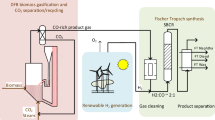In order to process refinery gas streams into environmentally friendly motor fuels, it has been proposed to use superacid catalytic systems based on sulfated zirconium oxide, mixed heteropoly acids, and nanosized nickel powder supported on acid-activated montmorillonite. We have studied the characteristics of the effects of temperature and catalyst composition on the oligomerization process of the butane—butene fraction, obtaining C5-C12 iso-olefins.






Similar content being viewed by others
References
V. M. Kapustin and E. A. Chernyshova, Principal Catalytic Oil Refining Processes. Industrial Catalysis in Lectures [in Russian], No. 5, Kalvis, Moscow, 2006, 128 pp.
A. V. Lavrenov, I. A. Basova, M. O. Kazakov, et al., Ross. Khim. Zh., 51, No. 4, 75-84 (2007).
Zh. F. Galimov and M. N. Rakhimov, Silica-phosphate Refinery Gas Oligomerization Catalysts. Synthesis, Properties and Application [in Russian], Reaktiv, Ufa, 1999, 164 pp.
V. N. Ipat’ev, Catalytic Reactions at High Temperatures and Pressures [in Russian], Akad. Nauk SSSR, Moscow-Leningrad, 1936, 776 pp.
R. R. Shiriyazdanov and S. A. Akhmetov, in: Proceedings of the International Scientific-Technical Conference “Current Problems of Nano-, Energy-, and Resource-Conserving and Ecologically Oriented Chemical Technologies” [in Russian], Izd. NTU KhPI, Kharkov, 2010, pp. 150-151.
P. Wasserscheid and M. Eichmann, Catal. Today, 66, 309-316 (2001).
A. V. Ivanov and L. M. Kustov, Ross. Khim. Zh., No. 2, 21-52 (2000).
V. I. Bogdan and V. B. Kazanskii, Kinet. Katal., No. 6, 881-885 (2005).
E. G. Kukovskii, Structural Features and Physicochemical Properties of Clayey Minerals [in Russian], Naukova Dumka, Kiev, 1966, 132 pp.
G. V. Kukolev, Chemistry of Silicon and Physical Chemistry of Silicates [in Russian], Vysshaya Shkola, Moscow, 1966, 464 pp.
W. E. Worrall, Clays and Ceramic Raw Materials, Wiley, New York, 1975.
V. P. Finevich, N. A. Alert, T. R. Karpova, et al., Ross. Khim. Zh., No. 4, 69-74 (2007).
Acknowledgments
The work was sponsored by State Task Project No. 10.2699.2014/K.
Author information
Authors and Affiliations
Corresponding author
Additional information
Translated from Khimiya i Tekhnologiya Topliv i Masel, No. 6, pp. 14 – 18, November – December, 2014.
Rights and permissions
About this article
Cite this article
Shiriyazdanov, R.R., Davletshin, A.R., Vil’danov, F.S. et al. Processing Refinery Gas Streams into Environmentally Friendly Motor Fuels on Next-Generation Catalysts. Chem Technol Fuels Oils 50, 465–471 (2015). https://doi.org/10.1007/s10553-015-0550-8
Published:
Issue Date:
DOI: https://doi.org/10.1007/s10553-015-0550-8




